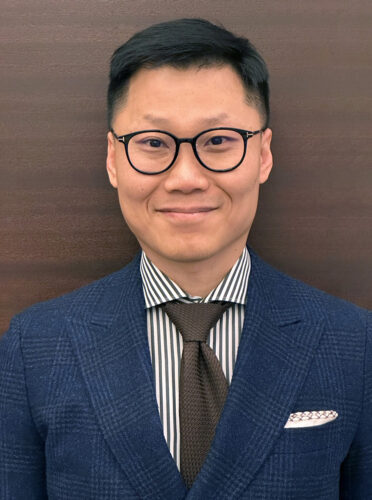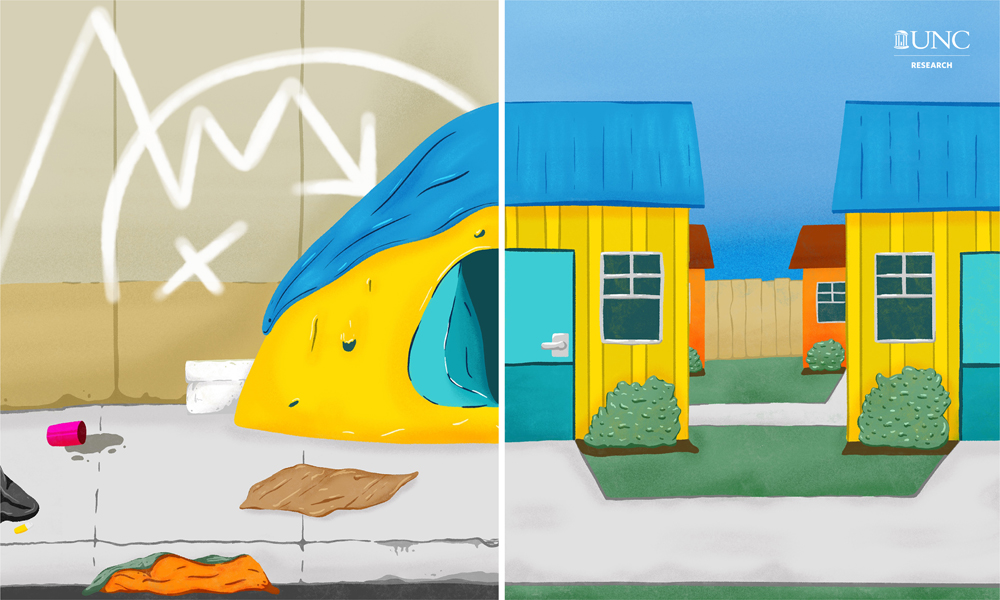Listen to the story:
Across the nation, more than 650,000 people don’t have homes — a statistic that grew by 12% in 2023. That’s the largest jump seen since the government began collecting data on this population in 2007. The Triangle is no exception. More than 6,000 people identify as homeless in Raleigh and Wake County. Durham now has twice as many unsheltered individuals since the pandemic began in 2020.
These numbers drive Hsun-Ta Hsu, who’s spent the last decade working with some of the largest homeless populations in the country, from Los Angeles to St. Louis, using an innovative and unexpected tool to address this problem: artificial intelligence (AI).
In July 2023, Hsu’s unique skillset lead him to Carolina, where he holds a joint appointment as a professor in the UNC School of Social Work and the new UNC School of Data Science and Society (SDSS).
“Dr. Hsu is a prime example of how interdisciplinary data science can create insights that transform a seemingly intractable, multi-level social issue into something solvable,” SDSS Dean Stan Ahalt says.
Ramona Denby-Brinson, dean of social work, mimics these sentiments.
“We are so fortunate to have recruited Dr. Hsu to Carolina,” she says. “His work advances our understanding of neighborhood structures, the development of effective intervention programs and services, and how we can employ social networks in more practical terms to produce better health and behavioral outcomes for the unhoused.”
A human right
While many people encounter social work through gateway fields like sociology, psychology, and anthropology, Hsu learned about it in high school. His advisor recommended he major in social work in college based on his background and interests.
“Growing up, I had relatives and people I was close to who were suffering with mental health-related issues, including suicide attempts and substance abuse,” he shares. “When I was younger, I didn’t know how to deal with it. So I was really thinking about that — and I wanted to do something about it.”

Hsun-Ta Hsu (photo courtesy of UNC School of Social Work)
Hsu went on to pursue bachelor’s, master’s, and PhD degrees in social work.
In 2010, at the start of his PhD program at the University of Southern California (USC), Hsu attended a school-sponsored tour of Los Angeles and was taken aback by the confluence of poverty and wealth in one particular area. Hsu had experienced a similar environment while designing after-school programs in southwest Detroit during his master’s program, but the economic divide here in Los Angeles was even starker.
Nearly 15,000 unsheltered individuals live in Skid Row, a 50-block neighborhood wedged between the arts and financial districts. Tents of all shapes and sizes speckle the street here, filling in gaps between apartment complexes and local businesses as high-rise condos and luxury stores loom in the background.
“I saw a young mother in a wheelchair breastfeeding her baby, surrounded by tents, bad smells, and extreme poverty,” Hsu recalls. “These people are constantly worried about raising their kids in an unsafe environment, where their next meal is coming from, and where they’re going to spend that night.
“That’s not okay,” he adds. “To me, housing is a human right.”
Location, location, location
During his PhD program, Hsu worked on a project with researchers who interviewed people before and after being housed through the Los Angeles Homeless Service Authority (LAHSA), which coordinates housing and services for homeless families and individuals in Los Angeles County. Hsu focused on analyzing this data — and quickly noticed two different perspectives.
“In general, people feel safer because now they have a roof and door they can lock,” he shares. “But when you look at the nuances, some feel safe within their housing but not their neighborhood. Others feel safe in both environments.”
Hsu mapped participants’ housing locations on Google Maps. Those housed within Skid Row only felt safe within their homes, while those on the periphery felt secure both inside and outside of their homes. In response, Hsu began canvassing the neighborhood, documenting characteristics like broken windows, graffiti, garbage, tents, smells, and the presence of children and families.
“The neighborhoods people feel safe in have less urban decay,” he says. “But people in Skid Row are surrounded by the environment they were homeless in. To quote them, they ‘feel homeless again.’ And living there retraumatizes them.”
Hsu documented neighborhood characteristics for 50 blocks, with each block taking about one to two hours to complete. This was a time-consuming, labor-intensive process — one Hsu thought could be improved with technology.
To learn how, he pursued a summer fellowship at the USC Center for Artificial Intelligence in Society (CAIS), which focuses on research using AI to solve the world’s biggest challenges. His time there would go on to fuel his next decade of projects.
This includes a platform on Google Maps where researchers can add annotations to the photos within the “street view” section. Through machine learning, Hsu wants to automate the identification of objects like garbage and broken-down cars, streamlining the work he spent hours doing by hand during his PhD program.
While its still under development, a mapping tool like this could be used to predict success for those who are rehoused. Hsu believes its potential extends beyond the housing crisis.
“Maybe I’m too optimistic, but I don’t think it’s limited to homelessness,” he says. “Think about hospitals. If we can utilize this tool with patient addresses to generate a neighborhood index, we can better understand how neighborhood environment impacts treatment outcomes.”
Community-centered research
To prioritize who gets housing, agencies often rely on a vulnerability index developed in 2010 to determine the best candidates. Cities across the country use this self-assessment survey to pre-screen individuals seeking help.
“It’s a triage tool like we use in the emergency room. It’s not first come, first serve. Doctors treat the most vulnerable first,” Hsu explains. “It’s a similar rationale in housing allocation. We are measuring how vulnerable one is on the street and then bumping them up on the priority list to get them housing.”
In 2019, as an assistant professor at the University of Missouri, Hsu teamed up with CAIS researcher Eric Rice to improve this tool for LAHSA. He combined demographic data from the Homelessness Management Information System (HMIS) with feedback from community stakeholders, including people with lived experiences of homelessness and others who aid this population like social workers, nonprofits, and policymakers.
“The community engagement piece is super important,” he says. “We need them to help us define who’s vulnerable, what’s considered successful, and how the system should respond. We’re trying to understand the nuances of what’s fair.”
The HMIS data revealed that people of color, those with physical and mental disabilities, members of the LGBTQ population, and lower income levels are more likely to experience homelessness. While these factors are often used to determine vulnerability, community members told Hsu they want to be considered for housing based on assets, not deficits.
“They want a strength-based approach. What am I good at? And what can I bring to the table? That’s something we’d like to look at,” Hsu says.
This feedback helped Hsu and Rice revise the vulnerability index survey to include questions focused on an individual’s positive traits. Then, he worked with computer scientists to develop an algorithm that combines that information with the HMIS data to create a more accurate tool for LAHSA to prioritize housing.
Now, Hsu is bringing this project model to rural communities, where homelessness is often more hidden and thus less prioritized than in cities. Nearly 87,000 Americans experience homelessness in these settings.
In 2023, he received funding from the National Alliance to End Homelessness to work with rural communities in Missouri, where he spent eight years as an assistant professor at the University of Missouri, Columbia. Hsu believes his research in both rural and urban homeless populations will aid future projects in North Carolina.
“I want to expand the model from L.A. and bring it to N.C. I believe Chapel Hill is a strategic point — you have urban and rural continuums of care,” Hsu says. “So we can come up with a tool to address both.”
He’s in the process of meeting with local homeless service providers to learn more about North Carolina’s processes and share how he’s helped other communities.
“Homelessness is a national issue,” Ahalt stresses. “This research will create a replicable process that can be used in North Carolina and across the country.”


